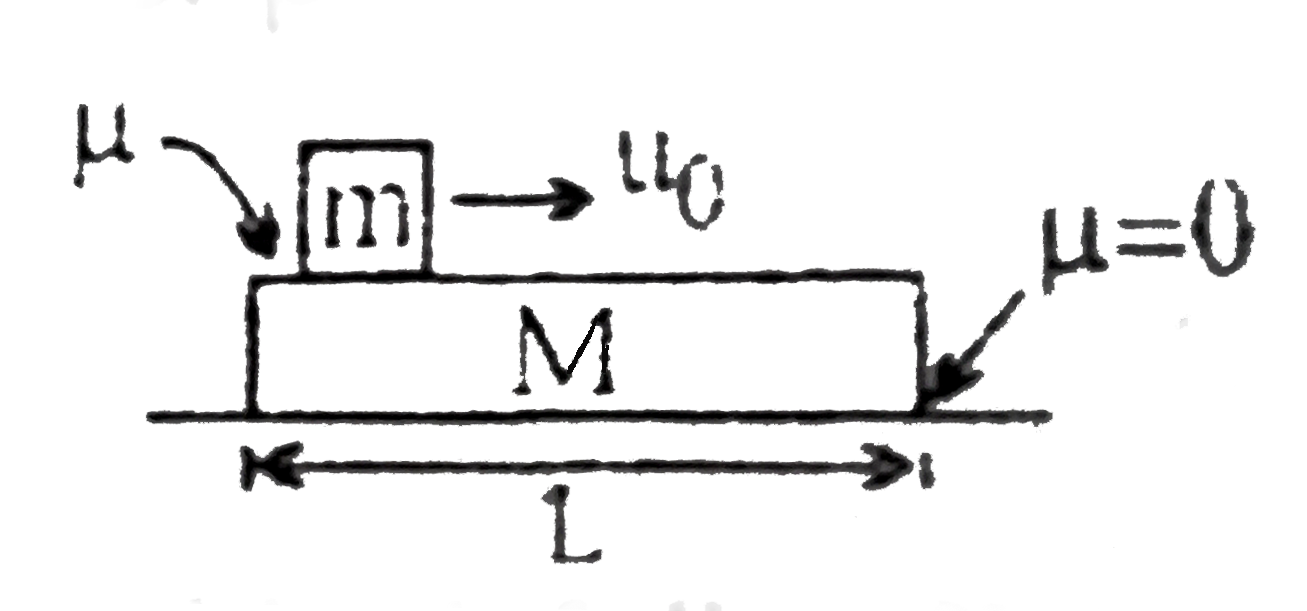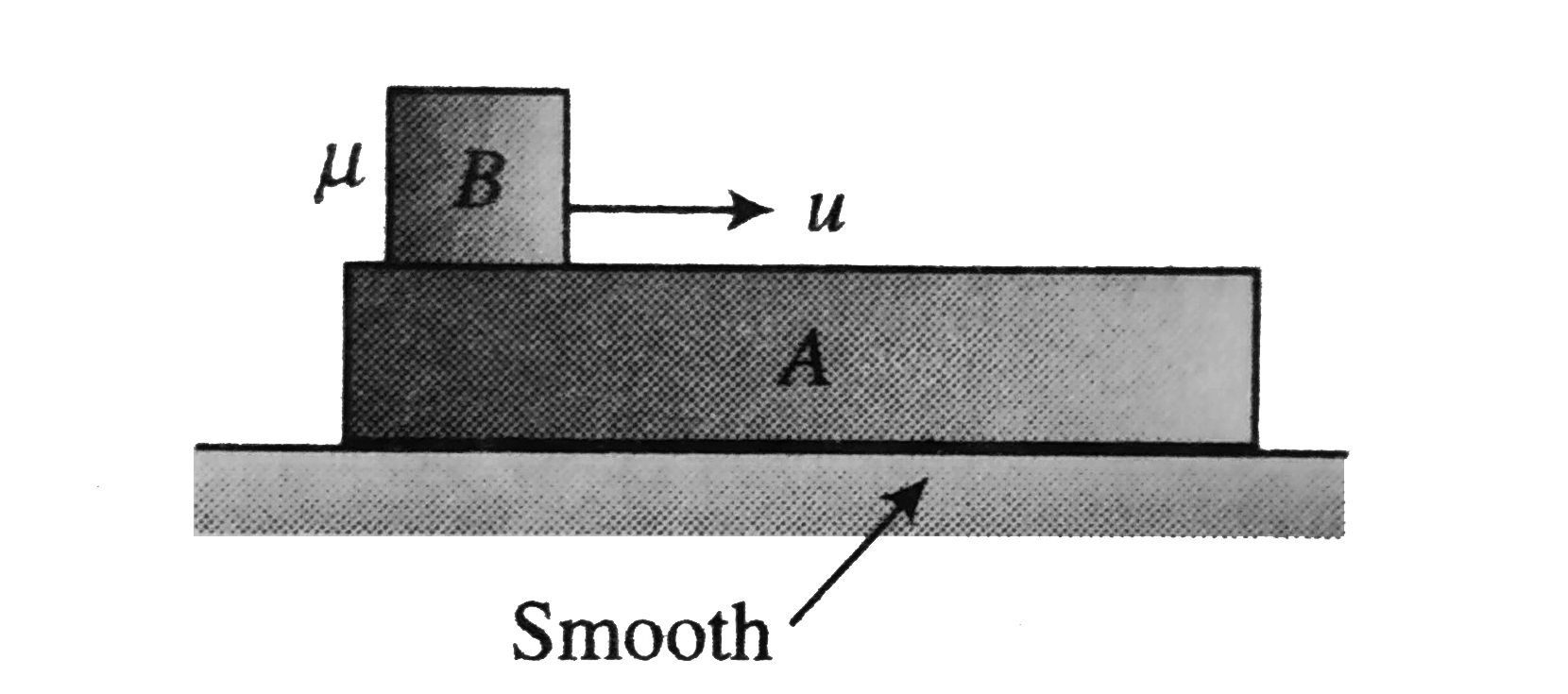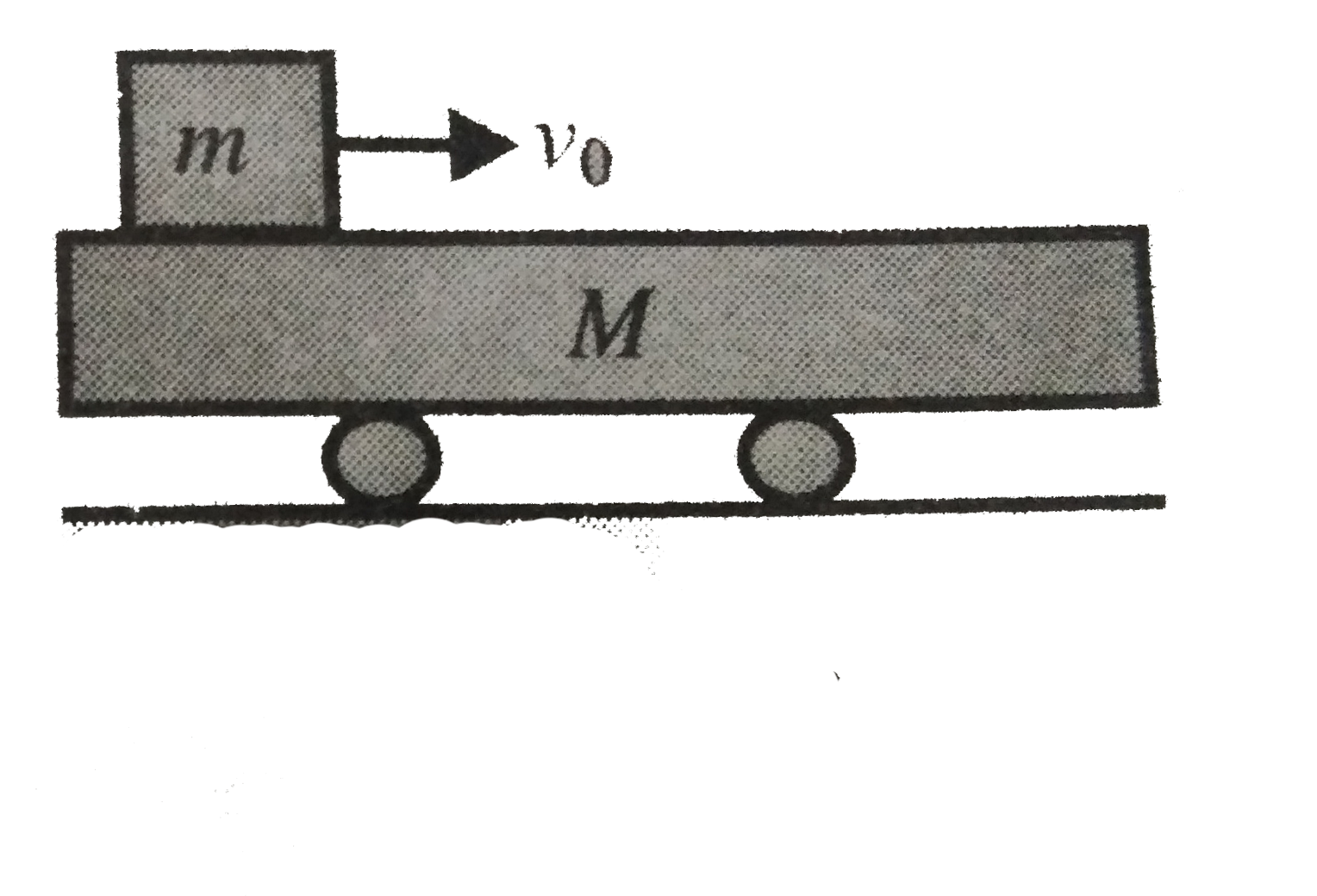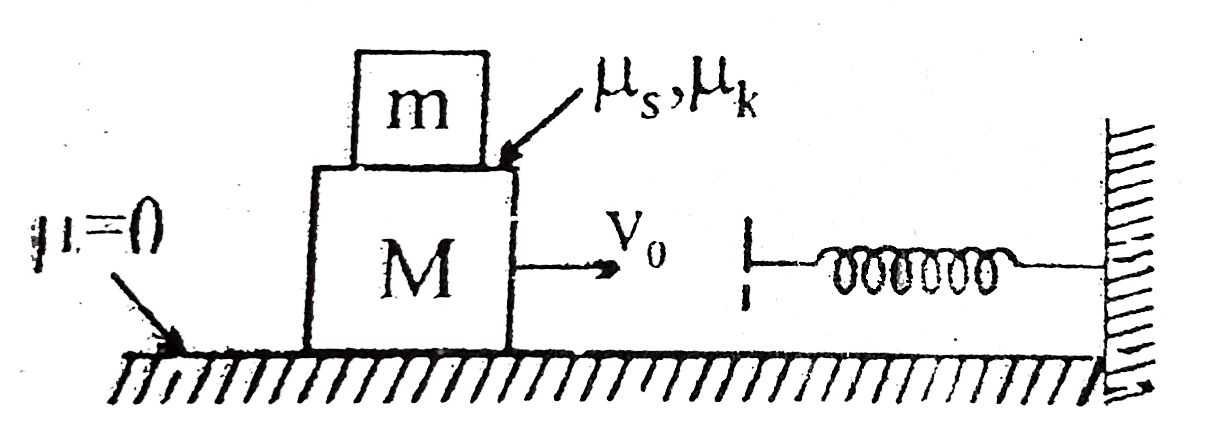A long plank of mass M is initially at rest on a frictionless surface. A small block with mass m and initial speed u0 slides on top of the larger plank. The coefficient of friction between the block and plank is μ

Net work done by friction if the top block falls off the plank after sliding over its length L is
−μmgL
−μ(M+mM)gL
−μ(MM+m)gL
−μMgL
The correct Answer is:A
Step by step video, text & image solution for A long plank of mass M is initially at rest on a frictionless surface. A small block with mass m and initial speed u_(0) slides on top of the larger plank. The coefficient of friction between the block and plank is mu Net work done by friction if the top block falls off the plank after sliding over its length L is by Physics experts to help you in doubts & scoring excellent marks in Class 12 exams.
Updated on:21/07/2023Topper's Solved these Questions
- DAILY PRACTICE PROBLEMBOOK - RESONANCECHAPTER - DAILY PRACTICE PROBLEMEXERCISE - DPP No.41
9 Videos
- DAILY PRACTICE PROBLEMBOOK - RESONANCECHAPTER - DAILY PRACTICE PROBLEMEXERCISE - DPP No.42
20 Videos
- DAILY PRACTICE PROBLEMBOOK - RESONANCECHAPTER - DAILY PRACTICE PROBLEMEXERCISE - DPP No.39
9 Videos
- CURRENT ELECTRICITYBOOK - RESONANCECHAPTER - CURRENT ELECTRICITYEXERCISE - High Level Problems (HIP)
21 Videos
- ELECTRO MAGNETIC WAVESBOOK - RESONANCECHAPTER - ELECTRO MAGNETIC WAVESEXERCISE - Exercise 3
27 Videos
Similar Questions
A plank of mass M and length L is placed at rest on a smooth horizontal surface A small block of mass m is projected wii:h a velocity v0 as shown in the Fig. 3.31 (a), The coefficient of friction between the block and the plank is μ, plank is very long so that block eventually comes to rest on it.
(i) Find the work done by the ftjctioh force on the block during the period it slides on the plank. Is the Work positive or negative ?'
(ii) Calculate the work done on the plank during the same period. Is the work positive or negative?
(iii) Also, determine the net work done by friction. Is it positive or negative ?

View SolutionA plank of mass M and length L is placed at rest on a smooth horizontal surface. A small block of mass m is projected with a velocity v0 from the left end of it as shown in figure. The coefficient of friction between the block and the plank is m, and its value is such that the block becomes stationary with respect to the plank before it reaches the other end.

a. Find the time and common velocity when relative sliding between the block and the plank stops.
b. Find the work done by the friction force on the block during the period it slides on the plank. Is the work positive or negative?
c. Calculate the work done on the plank during the same period. Is the work positive or negative?
d. Also, determine the net work done by friction, Is it positive or negative?
View Solution
Knowledge Check
A long block A is at rest on a smooth horizontal surface. A small block B whose mass is half of mass of A is placed on A at one end and is given an initial velocity u as shown in figure. The coefficient of friction between the blocks is μ.
 A(a) Finally both move with a common velocity 2u/3.B(b) Acceleration of B relative to A initially is 3μg/2 towards left.C(c) Magnitude of total work done by friction is equal to the final kinetic energy of the system.D(d) The ratio of initial to final momentum of the system is 1.
A(a) Finally both move with a common velocity 2u/3.B(b) Acceleration of B relative to A initially is 3μg/2 towards left.C(c) Magnitude of total work done by friction is equal to the final kinetic energy of the system.D(d) The ratio of initial to final momentum of the system is 1.A block of mass M slides on a frictionless surface with an initial speed of v0 . On top of block is small box of mass m . The coefficient of friction between box and block are μs and μk . The sliding block encounters an ideal spring with force constant k . Answer the following questions :

Suppose the value of k is just slightly greater than the value found in Q.2 , so that the box begins to slide just as the spring reaches maximum compression . The accelerations of box and block are respectively :AaBox=μkg,aBlock=m(μs−μk)+μsMMgBaBox=(μs−μk)g,aBlock=(μs−μk)mgMCaBox=μkg,aBlock=(μs+μk)mgMDnone of the aboveTwo block of masses m1 and m2 are connected with a massless unstretched spring and placed over a plank moving with an acceleration 'a' as shown in figure. The coefficient of friction between the blocks and platform is μ
 Aspring will be stretched if a>μgBspring will be commpressed if a≤μgCspring will neither be compressed nor be stretched for a<μg only.Dspring will be in its natural length under all conditions.
Aspring will be stretched if a>μgBspring will be commpressed if a≤μgCspring will neither be compressed nor be stretched for a<μg only.Dspring will be in its natural length under all conditions.
A block of mass m is pushed with a velocity v0 along the surface of a trolley car of mass M. If the horizontal ground is smooth and the coefficient of kinetic friction between the block of plank is μ. Find the minimum distance of relative sliding between the block and plank.

View SolutionA plank of mass 5 kg in kept on a smooth surface. A block of 1 kg is kept on it and is given a velcoity of 12 m/s. There is friction between the block and the plank. Assuming the plank to be very long, find the magnitude of work done (in Joules) by friction on block till the relative sliding between them stops.

View SolutionA block of mass M slides on a frictionless surface with an initial speed of v0 On top of block is a small box of mass m. the coefficients of friction between box and block are μ6andμk. The sliding block encounters and ideal spring with force constant K. Answer following questions. Suppose the value of k is just slightly greater then the value found in previous question, so that the box begins to slide just as the spring reaches maximum compression. The acceleration of box and block are repectively.

View SolutionA block of mass M slides on a frictionless surface with an initial speed of v0 . On top of block is small box of mass m . The coefficient of friction between box and block are μs and μk . The sliding block encounters an ideal spring with force constant k . Answer the following questions :

Assuming no relative motion between box and block what is the maximum possible acceleration of block and box at the instant of maximum compression ?
View SolutionA block of mass M slides on a frictionless surface with an initial speed of v0 . On top of block is small box of mass m . The coefficient of friction between box and block are μs and μk . The sliding block encounters an ideal spring with force constant k . Answer the following questions :

What is maximum value of k for which it remains true that box does not slide ?
View Solution